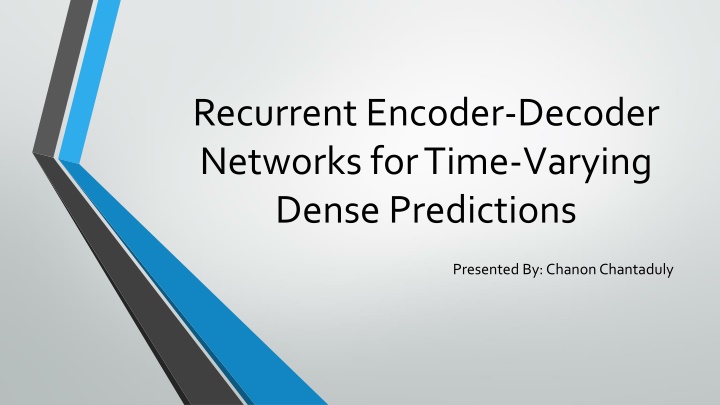
Recurrent Encoder-Decoder Networks in Time-Varying Predictions
Explore the power of Recurrent Encoder-Decoder Networks for time-varying dense predictions, challenges with traditional RNNs, modifications like GRU and LSTM, bidirectional RNNs, and the fusion of CNN and RNN in CRNN for spatial-temporal data processing.
Download Presentation

Please find below an Image/Link to download the presentation.
The content on the website is provided AS IS for your information and personal use only. It may not be sold, licensed, or shared on other websites without obtaining consent from the author. If you encounter any issues during the download, it is possible that the publisher has removed the file from their server.
You are allowed to download the files provided on this website for personal or commercial use, subject to the condition that they are used lawfully. All files are the property of their respective owners.
The content on the website is provided AS IS for your information and personal use only. It may not be sold, licensed, or shared on other websites without obtaining consent from the author.
E N D
Presentation Transcript
Recurrent Encoder-Decoder Networks for Time-Varying Dense Predictions Presented By: ChanonChantaduly
Time-Varying Dense Predictions Dense Predictions When we predict a label for each of the input units rather than the entire input Example: predicting the pixels that represent a cat Time-varying dataset Spatial and Temporal Example: video analysis, medical imaging
Recurrent Neural Networks (RNN) Primarily used in sequencing, where preservation of temporal information is needed. no no no no no yes a <3> a <4> a <1> a <2> a <0> a <5> The chicken butt t-shirt is Anthony s
Problems with RNNs Not very good at capturing long term dependencies Vanishing/exploding gradient problem Next layer gets information only from the previous layer What if we need information from later on in the sequence?
Modified RNNs Two main types Gated Recurrent Unit (GRU) Two gates Simpler model, which allows for building bigger models Long Short Term Memory (LSTM) Three gates More powerful historically, but higher computational costs
Information From The Future Bidirectional RNNs! yes no no no a<3> a<4> a<4> a<1> a<2> a<1> a<3> a<2> a<1> a<2> a<3> RNN #1 a<2> RNN #2 a<4> a<3> Pat loves Doge memes
Spatial vs Temporal Convolutional Neural Networks (CNN) are very good at preserving spatial information. Recurrent Neural Networks (RNN) are very good at processing temporal information. So how do we process datasets that require preserving both spatial and temporal information?
Convolutional Recurrent Neural Networks (CRNN) Combines together CNN and RNN by replacing the fully connected layers in the RNN with convolutional connections. Transforms GRU/LSTM to CGRU/CLSTM by adding the convolutional connections. Limitation: Very high computational cost/high memory consumption.
Incorporating CRNN units into FCN U-Net example: U-Net U-Net + 1 CLSTM/CGRU U-Net + 3 CLSTM/CGRU U-Net + 5 CLSTM/CGRU
